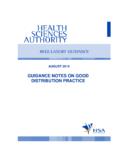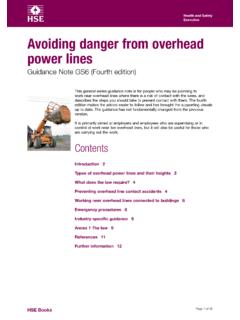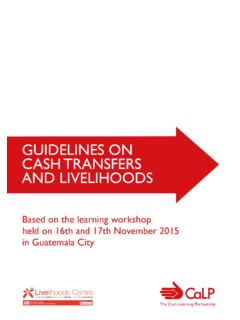Transcription of Bats & Lighting - Notice Nature
1 Bats & Lighting guidance notes for: Planners, engineers, architects and developers December 2010 Bat Conservation Ireland Daubenton s bat foraging over water ( Frank Greenaway) Daubenton s bat (illustrated in the photograph above), a member of the Myotis family group, commutes and forages along dark wildlife corridors such as rivers and consequently shies away from highly illuminated sections. Therefore, an illuminated structure such as a bridge can impede their flight to suitable feeding areas. Consideration should be given to ensure that dark wildlife corridors remain in the landscape to allow bats and other wildlife ( otters) to travel safely to and from feeding habitats. Bats & Lighting Lighting has increased dramatically over the last number of years as a result of many new developments. This includes aesthetic Lighting of bridges, monuments and buildings, flood Lighting of sports grounds, street and road Lighting and security Lighting of urban and rural areas to name but a few.
2 Lighting can impact on bats roosting sites, commuting routes and foraging areas. This leaflet aims to provide, for planners, Lighting engineers, Lighting designers and developers, information on the potential impacts of Lighting on bats and how this can be reduced. Important roosting sites Attics of buildings old and modern Underground structures caves and ice houses Crevices in stone work of old and modern bridges Tree holes, split limbs and dead wood of mature trees especially adjacent to water courses, in woodland and parkland Crevices in stone work of sluice gates, pumping stations and tidal barrages Trees with heavy ivy growth adjacent to water courses, along hedgerows and in woodland and parkland Important foraging areas Watercourses, especially those lined with hedgerows and treelines Watercourses flowing through wooded areas Hedgerows and treelines Extensively managed and grazed pasture Woodland and parkland Recognising potential roosting sites for bats It is often difficult to tell if a structure is used as a bat roost because these small mammals can tuck themselves away out of sight.
3 Therefore, it is important to be vigilant for suitable roosting sites and for more obvious signs of occupation such as bat droppings. Irish bats are very small and a crevice greater than 50mm deep and 12mm wide can be used as a bat roost or allow the bat to access a larger chamber within the structure behind the crevice. This 3D shape is 12mm high/wide and 50mm long, illustrating the dimensions of a suitable crevice for a single bat to use as a roost or access a roost. Other evidence to be aware of includes grease stains around access holes. As bats squeeze themselves through crevices oil from their fur can leave dark polished surfaces indicating bat usage. In addition, the lack of cobwebs around a crevice can also indicate that it is used by bats. Crevices should be checked by using a high powered narrow beam torch light or an endoscope. A single soprano pipistrelle was found in this crevice. Above: Natterer s bat (Photo: Tina Aughney).
4 Below: Daubenton s bat (Photo: Tina Aughney). Bats and the Law Due to increasing pressure on bat populations, all Irish bat species are protected by the 1976 Wildlife Act and 2000 Amendment. They are also protected under the EU Habitats Directive. Consequently, it is a criminal offence to Intentionally kill, injure or take a bat Possess or control any live specimen or anything derived from a bat Wilfully interfere with any structure or place used for breeding or resting by a bat Wilfully interfere with a bat while it is occupying a structure or place which it uses for that purpose This is a brief summary of the main points of the law. Further details of the Wildlife Act and the Habitats Directive may be found on More information about bats and their conservation can be sourced from the following documents: McAney, K. (2006) A conservation plan for Irish Vesper bats. Irish Wildlife Manuals No. 25. National Parks & Wildlife Service, DoEHLG.
5 Kelleher, C. & Marnell, F (2006) Bat mitigation guidelines for Ireland, Irish Wildlife Manuals No. 25. National Parks & Wildlife Service, DoEHLG. Marnell, F. & Presetnik, P. (2009) Protection of Overground roosts for bats, EUROBATS Publication Series No. 4. Mitchell-Jones, & A. P. McLeish [Eds.] (2004) Bat Worker s Manual, 3rd Edition. Joint Nature Conservation Committee Peterborough. If a bat is encountered during operations, please stop works and contact your local NPWS Conservation Ranger. The national helpline number is 1800 405 000. Ireland s bat fauna Ireland s bat fauna is comprised of ten species, which forms one third of Ireland land mammals. Nine species are vesper bats and all vespertilionid bats have a tragus (cartilaginous structure found inside the pinnea of the ear) and are distributed throughout the country. Nathuius pipistrelle and Brandt s bat are recent editions to the list. Common pipistrelle Pipistrellus pipistrellus Soprano pipistrelle Pipistrellus pygmaeus Nathusius pipistrelle Pipistrellus nathusii Leisler s bat Nyctalus leisleri Brown long-eared bat Plecotus auritus Natterer s bat Myotis nattererii Whiskered bat Myotis mystacinus Brandt s bat Myotis brandti Daubenton s bat Myotis daubentoni The tenth species, the lesser horseshoe bat Rhinolophus hipposideros, belongs to the Rhinolophids and has a complex nose leaf structure.
6 This species current distribution is confined to the western six counties: Mayo, Galway, Clare, Limerick, Kerry and Cork. Bats are a species rich group widely distributed throughout a range of habitats in the Irish landscape. Due to their reliance on insect populations, specialist feeding behaviour and habitat requirements, they are considered to be valuable environmental indicators of the wider countryside. Ireland s bat fauna Ireland s bat fauna is comprised of nine resident species, forming one third of Ireland s land mammals. Eight species are vesper bats and all vespertilionid bats have a tragus (cartilaginous structure found inside the pinna of the ear). Vesper bats are distributed throughout the country. Nathusius pipistrelle is a recent addition to the Irish list while the Brandt s bat is a potential tenth species. Common pipistrelle Pipistrellus pipistrellus Soprano pipistrelle Pipistrellus pygmaeus Nathusius pipistrelle Pipistrellus nathusii Leisler s bat Nyctalus leisleri Brown long-eared bat Plecotus auritus Natterer s bat Myotis nattereri Whiskered bat Myotis mystacinus Brandt s bat Myotis brandtii Daubenton s bat Myotis daubentonii The ninth resident species, the lesser horseshoe bat Rhinolophus hipposideros, belongs to the Rhinolophidea and has a complex nose leaf structure.
7 This species current distribution is confined to the western counties of: Mayo, Galway, Clare, Limerick, Kerry and Cork. Bats are widely distributed throughout a range of habitats in the Irish landscape. Due to their reliance on insect populations, specialist feeding behaviour and habitat requirements, they are considered to be valuable environmental indicators of the state and condition of the wider countryside. Bat species such as the lesser horseshoe bat (above) regularly light sample before leaving the roost to feed at night time. Light sampling is where the bat flies in and out of the exit point to determine the light levels. The bat will not fully leave the roost until the light levels are low enough for it to leave the roost safely. This process of light sampling emphasises the need to strictly control Lighting being used around bat roosts. Delayed emergence can occur as a result of Lighting and this can impact on the bats by reducing the time available for feeding.
8 Each species of bat has an optimum level of light for emergence. For example, Daubenton s bats prefer a light level of less than 1 lux. To put this in perspective, lux level is equivalent to moonlight. While all bat species have a low tolerance for light levels, the following bat species are particularly sensitive to elevated light levels: brown long-eared bat, whiskered bat, Natterer s bat, Daubenton s bat and lesser horseshoe bat. Bat Vision and Lighting Impacts Contrary to common belief, bats are not blind. While bats tend to rely on a type of sonar, known as echolocation, for orientation and hunting during the hours of darkness, vision is still an important sense for bats. When bats emerge from roosts early in the evening, they tend not to echolocate but rely on eyesight to fly from the roost to adjoining treelines or hedgerows. Various studies have shown that bats eyesight works best in dim light conditions.
9 Where there is too much luminance, bats vision can be reduced resulting in disorientation. While light sensitivity varies between species, bats tend to have a higher tolerance for red visual light than white light. Short wave frequency (UV) light is most disturbing for bats. This is due to the fact that bats have a higher proportion of rods in their retina compared to cones. The rods allow greater absorption of light in dim conditions. Too much luminance at bat roosts may cause bats to desert a roost. Light falling on a roost exit point can delay bats from emerging and miss peak levels of insect activity at dusk. Any delays of emergence can reduce feeding periods. Lighting can also disturb bats feeding behaviour. Many night flying insects are attracted to lights especially those lamps that emit UV light. A single source of light in a dark area can cause local insect populations to congregate in concentrations around the light source.
10 While some Irish bat species such as Leisler s bats will opportunistically feed on such insect gatherings, the majority of Irish bat species are too sensitive to such light sources and suffer from insect populations being reduced in traditional feeding areas. In addition, artificial Lighting can increase the chances of bats being preyed on. Lighting can be particularly harmful to bat populations along river corridors, woodland edges, along hedgerows and treelines and at lake edges. How can planning influence Lighting strategies? Planning conditions in relation to Lighting are an important way for planning authorities to influence the design of light installations and potentially mitigate their impacts. Such conditions could include: 1. Hours of illumination provide some hours of darkness. 2. Light levels install Lighting that meets the lowest light levels permitted under health and safety.















